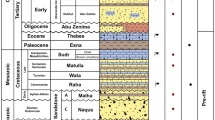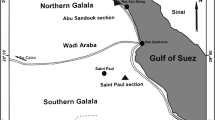Abstract
The Middle Eocene Lutetian Samalut formation is among the best examples of anisotropic fossiliferous rocks in Egypt, where the effect of the anisotropic Nummulite Gizehensis fossils on the petrophysical behavior can be traced. The Samalut formation has been sampled and studied at Wadi Feiran in SW Sinai. Petrographically, it is composed of two microfacies; Nummulitic packstone and Fusulinid mudstone. Tight cementation by micro to pseudosparite, aggrading neomorphism and compaction with increasing load pressure are the most important porosity-reducing factors. The anisotropy of the fossil content (λF), due to shape and orientation, and its effect on the petrophysical properties were assigned by measuring the lengths of the longest and shortest axes. Petrophysically, both microfacies are characterized by low porosity values (1.47 ≤ \({\emptyset _{{\text{He}}}}\) ≤ 5.29%). The formation resistivity factor (F) and permeability (k) were measured in the horizontal and vertical directions (parallel and perpendicular to the bedding plane, respectively). The studied samples are characterized by high to very high formation resistivity factor (190 ≤ F ≤ 8938) and relatively very low permeability (0.012 ≤ k ≤ 0.110 md). The studied samples are characterized by fair to medium electric anisotropy ‘λE’, which is attributed to a relatively medium to fair degree of electric foliation. It has been shown that, the fossil shape anisotropy and orientation ‘λF’ (1.5 ≤ λF ≤ 3.5) is the main contributor for the electric and permeability anisotropy that corrected for the same porosity value (1.61 ≤ λEC ≤ 2.25 and 1.03 ≤ λkC ≤ 2.04; respectively). Foliation of the studied microfacies has been contributed to the orientation of the fossil remains parallel to the bedding plane. The anisotropy degree is relatively greater for the Nummulitic packstone microfacies than that of the Fusulinid mudstone. The present study refers to the possible anisotropic effect of fossil content (due to shape and orientation) on the petrophysical properties of the studied rocks which may be extended to the anisotropy of reservoir rocks on the bedding scale.
Similar content being viewed by others
References
Abuseda H, Kassab MA, Lala AM, El Sayed NA (2015) Integrated petrographical and petrophysical studies of some eocene carbonate rocks, Southwest Sinai, Egypt. Egypt J Pet 24:213–230
Abu-zeid MM, Hassanien IM, Abu El-Ezz AR, Ibrahim IH (2001) Petrology, depositional history and diagenesis of the eocene rocks in West Central Sinai, Egypt. Egypt J petrol 10(2):111–132
Awad MH, Sharaf-Eldin AA, El-Shahat OR (2010) Petrography and depositional environment of the paleocene-eocene sequence in Hammam Faraun, southern Sinai, Egypt. Aust J Basic Appl Sci 4(7):1597–1625
Bishay Y (1961) Biostratigraphic study of the eocene in the eastern desert between samalut and assiut by the large foraminifera. In: 3rd Arab petroleum congress, Alexandria, p 7
Choquette PW, Pray LC (1970) Geologic nomenclature and classification of porosity in sedimentary carbonates. Bull AAPG 54(2):207–250
Dunham RJ (1962) Classification of carbonate rocks according to depositional texture. American Association of Petroleum Geology, Tulsa, pp 108–121
El-Heiny I, Morsi S (1986) Review of the upper eocene deposits in the Gulf of Suez, Egypt. E.G.P.C. In: 8th exploration conference, Cairo, p 18
El-Heiny I, Enani N, Morsi S (1990) Stratigraphic evaluation of eocene rocks in West Central Sinai, Egypt. E.G.P.C. In: 10th exploration Conference, Cairo, p 22
Embry AF, Klovan JE (1972) A Late Devonian reef tract on northeastern banks of Island, Northwest Territories. Bull Can Petrol Geol 19:730–781
Flügel E (1982) Microfacies analysis of limestones. Springer, Berlin
Folk RL (1974) Petrology of sedimentary rocks. Hemphill Pub. Co, Austin
Harrell JA (2004) Petrographic investigation of Coptic limestone sculptures and reliefs in the Brooklyn Museum of Art. PalArch’s J Archaeol Egypt/Egyptology 1(1):1–16
Harrell JA (2012) Building stones. In: Wendrich W et al (eds) UCLA Encyclopedia of Egyptology, Los Angeles. http://digital2.library.ucla.edu/viewItem.do?ark=21198/zz002c10gb
Hassan HF (2005) Paleogene Sea level fluctuation across Sinai: a sequence stratigraphic approach. PhD Thesis, Suez Canal University, Ismailia
Issawi B, El-Hinnawi M, ElKhawaga L, Labib S, Anani N (1981) Contribution to the geology of Wadi Feiran Area, Sinai, Egypt. Geol Surv Egypt (Internal Report) 1–43
Mavko G, Mukerji T, Dvorkin J (2009) The rock physics handbook: tools for seismic analysis of porous media, 2 edn. Cambridge University Press, London
Nabawy BS (2013) Impacts of dolomitization on the petrophysical properties of the Cenomanian El-Halal Formation, north Sinai, Egypt. Arab J Geosci 6:359–373
Nabawy BS (2014) Estimating porosity and permeability using digital image analysis (DIA) technique for highly porous sandstones. Arab J Geosci 7:889–898
Nabawy BS (2015) Impacts of the pore- and petro-fabrics on porosity exponent and lithology factor of Archie’s equation for carbonate rocks. J Afr Earth Sci 108:101–114
Nabawy BS, Al-Azazi NAS (2015) Reservoir zonation and discrimination using the routine core analyses data: the upper Jurassic Sab’atayn sandstones as a case study, Sab’atayn basin, Yemen. Arab J Geosci 8(8):5511–5530
Nabawy BS, ElHariri TYM (2008) Electric fabric of Cretaceous clastic rocks in Abu Gharadig basin, Western Desert. Egypt J Afr Earth Sci 52(1–2):55–61
Nabawy BS, Rochette P, Géraud Y (2009) Petrophysical and magnetic pore network anisotropy of some cretaceous sandstone from Tushka Basin, Egypt. Geophys J Int 177(1):43–61
Nabawy BS, Rochette P, Géraud Y (2010) Electric pore fabric of the Nubia sandstones in south Egypt: characterization and modelling. Geophys J Int 183:681–694
Nabawy BS, Sediek KN, Nafee SA (2015) Pore fabric assignment using electrical conductivity of some Albian–Cenomanian sequences in north Eastern Desert, Egypt. Arab J Geosci 8(8):5601–5615
Nabway BS, Kassab MA (2014) Porosity-reducing and porosity-enhancing diagenetic factors for some carbonate microfacies: a guide for petrophysical facies discrimination. Arab J Geosci 7(11):4523–4539
Serra O (1988) Fundamentals of well-log interpretation: 1: the acquisition of logging data, 3rd edn. Elsevier, Amsterdam
Timur A (1968) An investigation of permeability, porosity and residual water saturation relationships for sandstone reservoirs. The Log Analyst, SPWLA-1968-vIXn4a2 9(4):1–8
Wahab SA, Khalifa MAG (1984) Sedimentology of the middle Eocene Minia and Samalut formations, West Beni Mazar, Western Desert, Egypt. J Afr Earth Sci 2(4):341–350
Worthington PF (1985) Evolution of shaley sand concepts in reservoir evaluation. Log Anal 26:23–40
Acknowledgements
I would like to thank the reviewers for their constructive comments that improved and reconstructed the manuscript. I would like also to thank the Editor Prof Dr. Wu-Cheng Chi whose patience and insightful suggestions have led to a new concise revised version.
Author information
Authors and Affiliations
Corresponding author
Rights and permissions
About this article
Cite this article
Nabawy, B.S. Impacts of fossil anisotropy on the electric and permeability anisotropy of highly fossiliferous limestone: a case study. Mar Geophys Res 39, 537–550 (2018). https://doi.org/10.1007/s11001-017-9335-2
Received:
Accepted:
Published:
Issue Date:
DOI: https://doi.org/10.1007/s11001-017-9335-2














